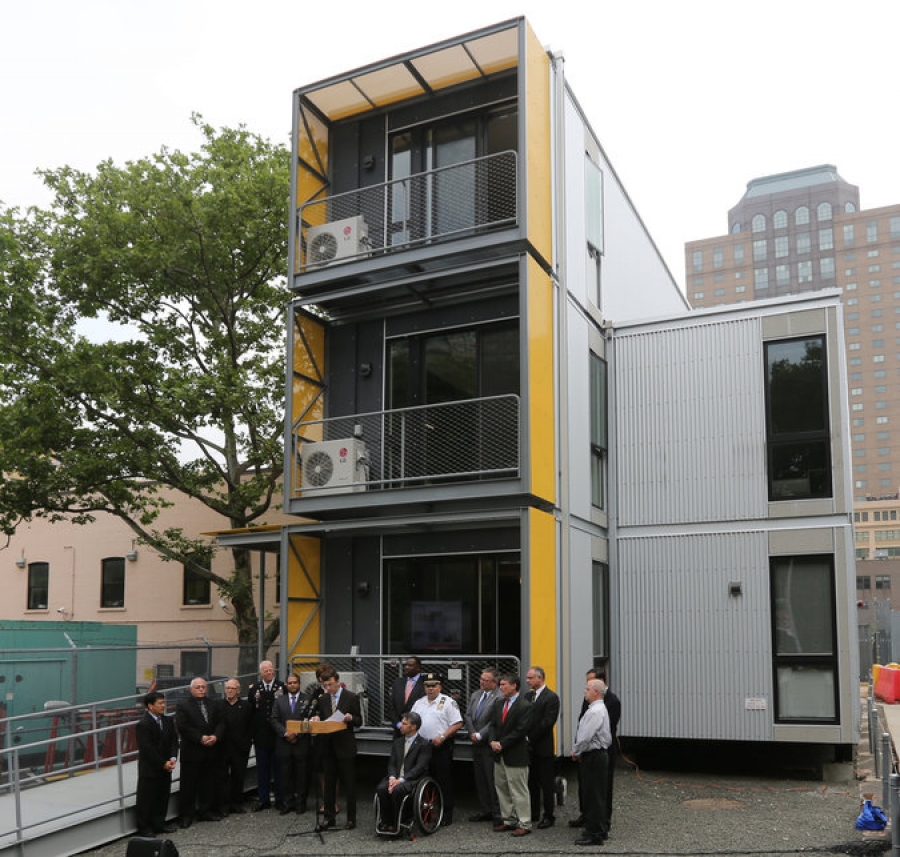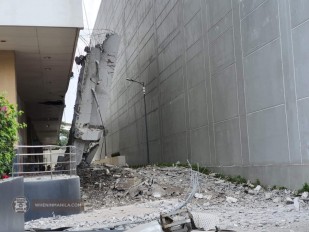New York Unveil Emergency Housing Unit Prototype

New York City officials unveiled an emergency housing unit prototype at a parking lot in Brooklyn on Tuesday. The prototype was developed in response to the aftermath of Hurricane Sandy. All available apartments in the city were rented shortly after the storm ended by people whose homes were damaged by the storm. However there was not nearly enough vacant apartments to handle the demand and many people became sick of living in hotel rooms. Many New Yorkers had no other choice except to remain in their damaged, water-logged homes.
City officials have been listening to scientists who believe that superstorms similar to Sandy will become more common. Joseph F. Bruno, the commissioner of the New York City Office of Emergency Management, which helped oversee the project, believes the Emergency Housing Unit prototype is far better than anything the city could currently offer to disaster victims. The three story shelter consists of three apartments stacked on top of one another. While the prototype in no way offers many amenities, other than a full kitchen and a dry place to sleep, it is a significant upgrade from the Federal Emergency Management Agency trailers used after Hurricane Katrina. The units inside of the prototype range from a 480 square-foot one-bedroom unit to an 813 square-foot three-bedroom unit.
It currently costs around $350,000 to $400,000 to build each unit, however, the city believes they can cut the costs in half though mass production. It took seven flatbed trucks to move all the materials for the prototype to the parking lot in Brooklyn. Officials would like to find a way to build the units where they are manufactured and ship them in after a disaster. While the cost to the prototype could be prohibitive, the larger problem with temporary emergency housing is finding a place for it in crowded cities like New York. City officials spent over a year trying to sort out permitting issues for the prototype because it would be considered a permanent residence. Under current laws, each apartment would need to undergo an inspection before disaster victims could move in. Finally, New York officials are also working on a way to ensure that the Emergency Housing Units do not become permanent apartments for people. There were still 3,000 people living in FEMA trailers four years after Hurricane Katrina. New York is committed to building quality emergency housing so it will not need to rebuild or redesign the units ten years from now.
Source: NY Times
Want to read more like this story?

Flats hosted inside water pipes may be a solution to Hong Kong's housing crisis
Jan, 29, 2018 | NewsA local architect, with his ‘Opod Tube Housing’ project, aims to build low-cost, stackable apartment...

New York Governor Outlines Sandy Rebuilding Plan
Jan, 09, 2014 | NewsNew York Governor Andrew Cuomo unveiled a plan recently to spend $17 billion in federal disaster aid...

Dubai Sustainable City Construction Underway
Mar, 24, 2014 | NewsDiamond Developers has begun construction on the $300 million Sustainable City located just outside...

World's most expensive city to build
Apr, 15, 2019 | NewsSan Francisco has recently turned into the most expensive city to build in the world. San Francis...

New York City’s Infrastructure Needs $47 Billion in Repairs
Mar, 12, 2014 | NewsThe Center for an Urban Future released a report yesterday titled Caution Ahead: Overdue Investments...

Miami’s Brickell Center Tower Nearly Half Sold
Aug, 11, 2014 | NewsDespite only being half completed, the Brickell Center Tower in Miami is already the city’s most ant...

236 New High-Rise Buildings Planned for London’s Skyline
Mar, 14, 2014 | NewsA new study published, by the New London Architecture think tank on Wednesday, found that there are...

Self-deploying building unfolds in just 10 minutes
Mar, 29, 2018 | NewsAn innovative solution for mobile housing The UK-based Ten Fold engineering came up wit...

3-storey residential unit made of shipping container material!
Apr, 22, 2015 | NewsA residential model unit built exclusively out of recycled steel shipping containers is now a realit...
Trending

Spectacular interchanges around the world

Eshima Ohashi bridge in Japan designed for the brave!

Building partially collapses in Philippines: 2 people injured

Concrete Component Design Using STAAD.Pro

Precast and prefabricated concrete structures: What is the difference?



